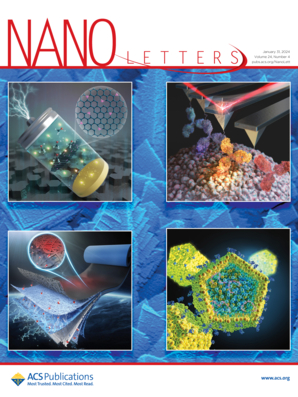Multi-Heteroatom-Doping and Defect Co-Engineered Hollow Carbon Nanocages for Ultralong-Cycle Zinc-Air Batteries.
IF 9.6
1区 材料科学
Q1 CHEMISTRY, MULTIDISCIPLINARY
引用次数: 0
Abstract
Developing cost-effective oxygen reduction reaction (ORR) electrocatalysts with simultaneously enhanced activity and durability remains a critical challenge for zinc-air batteries (ZABs). Herein, a multi-heteroatom-doping and defect co-engineering strategy is proposed to construct nitrogen, phosphorus, and sulfur tridoped hollow carbon nanocages (NPS-HCs) through a facile template-induced pyrolysis of a ZIF-8@PZS precursor. The synergistic effect of multi-heteroatom doping and introducing defects creates abundant active species, while the hollow architecture facilitates mass/electron transport during the ORR process. As a result, the optimized NPS-HC-900 catalyst demonstrates exceptional ORR performance with a high half-wave potential (E1/2 = 0.87 V vs RHE). Impressively, the NPS-HC-900 + IrO2-assembled rechargeable ZABs achieve an ultralong cycling stability over 1000 h. In situ spectroscopy and theoretical calculations verify that this synergistic effect promotes the conversion of key intermediate *OOH to *O, thereby significantly facilitating the ORR o. This work provides a paradigm-shifting platform for designing high-performance multi-heteroatom-doped carbon electrocatalysts via synergistic defect engineering.超长循环锌-空气电池用多杂原子掺杂与缺陷协同设计的空心碳纳米笼。
开发经济高效的氧还原反应(ORR)电催化剂,同时提高活性和耐久性,是锌空气电池(ZABs)面临的关键挑战。本文提出了一种多杂原子掺杂和缺陷协同工程的策略,通过模板诱导裂解ZIF-8@PZS前驱体来构建氮、磷、硫三掺杂的中空碳纳米笼(nps - hc)。多杂原子掺杂和引入缺陷的协同效应产生了丰富的活性物质,而空心结构促进了ORR过程中质量/电子的传递。结果表明,优化后的NPS-HC-900催化剂具有优异的ORR性能,具有较高的半波电位(E1/2 = 0.87 V vs RHE)。令人印象深刻的是,NPS-HC-900 + iro2组装的可充电ZABs实现了超过1000小时的超长循环稳定性。原位光谱和理论计算验证了这种协同效应促进了关键中间体*OOH向*O的转化,从而显著促进了ORR O的发生。这项工作为通过协同缺陷工程设计高性能多杂原子掺杂碳电催化剂提供了一个范式转换平台。
本文章由计算机程序翻译,如有差异,请以英文原文为准。
求助全文
约1分钟内获得全文
求助全文
来源期刊

Nano Letters
工程技术-材料科学:综合
CiteScore
16.80
自引率
2.80%
发文量
1182
审稿时长
1.4 months
期刊介绍:
Nano Letters serves as a dynamic platform for promptly disseminating original results in fundamental, applied, and emerging research across all facets of nanoscience and nanotechnology. A pivotal criterion for inclusion within Nano Letters is the convergence of at least two different areas or disciplines, ensuring a rich interdisciplinary scope. The journal is dedicated to fostering exploration in diverse areas, including:
- Experimental and theoretical findings on physical, chemical, and biological phenomena at the nanoscale
- Synthesis, characterization, and processing of organic, inorganic, polymer, and hybrid nanomaterials through physical, chemical, and biological methodologies
- Modeling and simulation of synthetic, assembly, and interaction processes
- Realization of integrated nanostructures and nano-engineered devices exhibiting advanced performance
- Applications of nanoscale materials in living and environmental systems
Nano Letters is committed to advancing and showcasing groundbreaking research that intersects various domains, fostering innovation and collaboration in the ever-evolving field of nanoscience and nanotechnology.
 求助内容:
求助内容: 应助结果提醒方式:
应助结果提醒方式:


